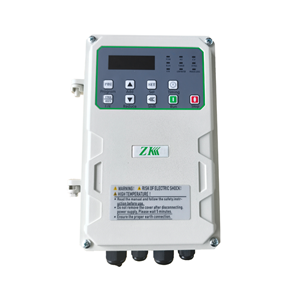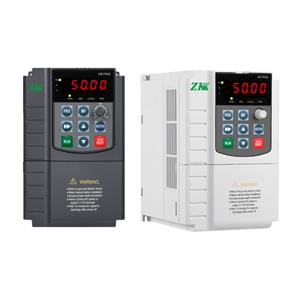Application of solar inverter in solar water pump field
Global environmental pollution and energy shortages have forced people to work harder to find and develop new energy sources. In the process of finding and developing new energy sources, people naturally turn their attention to various renewable alternative energy sources. Wind power, nuclear power, hydropower, solar energy, etc. Photovoltaic power generation is one of them. Although there are various limitations in the practical application of photovoltaic power generation, with the reduction of photovoltaic power generation costs, the increase of mineral power generation costs and the reduction of mineral energy, photovoltaic power generation has gradually entered the commercialization stage.
1. Basic principles of photovoltaic power generation
Solar cells are mainly made of single crystal silicon. Single crystal silicon is used to make a p-n junction similar to a diode, and its working principle is similar to that of a diode. However, in a diode, the external electric field drives the movement of holes and electrons in the p-n junction, while in a solar cell, the sun's photons and light radiation heat (*) drive and affect the movement of holes and electrons in the p-n junction. This is also known as the photovoltaic effect principle. The current efficiency of photoelectric conversion, that is, the efficiency of photovoltaic cells, is about 13%-15% for single crystal silicon and 11%-13% for polycrystalline silicon. The latest technology also includes photovoltaic thin-film cells.
2. Classification of Solar Photovoltaic Power Generation Systems
At present, solar photovoltaic power generation systems can be roughly divided into three categories: off-grid photovoltaic power storage system, photovoltaic grid-connected power generation system and the hybrid system of the first two. Off-grid photovoltaic power storage system is a common solar energy application method. It has been used at home and abroad for several years. The system is relatively simple and has wide adaptability. Only because of the large size and difficult maintenance of its series of batteries, the scope of use is limited.
3. Composition of Solar Photovoltaic System
1). Solar photovoltaic cells (solar substrates): realize photoelectric conversion
2). Storage batteries: storage batteries are key components in photovoltaic power generation systems, used to store electricity converted from photovoltaic cells. At present, there are no special batteries for photovoltaic systems in my country, but conventional lead-acid batteries are used.
3). DC inverter: its function is to realize the conversion of DC to AC, so the most important indicators of this component are reliability and conversion efficiency. The AC converted by the AC inverter maximizes the power converted by the photovoltaic cell into the power grid or directly supplies it to electrical equipment.
4. Introduction of Photovoltaic Water Pump System
The photovoltaic water pump system is a typical integrated system of light, machine and electricity. It uses solar cells to directly convert solar energy into electrical energy, and then converts it into AC power through the inverter link, drives the AC asynchronous motor to drive the water pump, and takes water from deep wells, rivers, lakes, ponds and other water sources for use. The system is widely used in desert control, residents' lives, agricultural irrigation, greening irrigation, grassland animal husbandry, scenic fountains, water treatment projects, etc. The photovoltaic water pump system has the following characteristics:
1). The photovoltaic water pump system is fully automatic and does not require manual supervision. The system consists of photovoltaic cells (solar substrates), batteries (according to customer needs), photovoltaic dedicated inverters, water pumps, water storage devices, etc.
2). Use a dedicated inverter for photovoltaic water pumps to adjust the speed of the water pump according to the changes in sunlight intensity, so that the output power is close to the maximum power of the solar cell array; when the sunlight is sufficient, ensure that the speed of the water pump does not exceed the rated speed; when the sunlight is insufficient, it will automatically stop running according to whether the set minimum operating frequency is met, otherwise it will stop running automatically.
3). The water pump is driven by a three-phase AC motor to draw water from a deep well and inject it into a water storage tank/pond, or directly connect it to the irrigation system. Different types of water pumps can be used to work according to actual system requirements and installation conditions.4. Economical and effective solutions can be provided according to different regional and customer needs.
5. Characteristics and applications of SU100 series inverters
The inverter is a new series of products developed by ZK based on the characteristics of photovoltaic inverters after repeated field tests. At present, it has been widely used in dozens of countries and regions near the equator in Asia, Africa and South America. Its excellent performance and stable and reliable operation have won unanimous praise from customers. The features of this product are as follows:
(1) Built-in high-precision photovoltaic array maximum power point tracking MPPT system, intelligent tracking of maximum power point, fast response, high stability and high efficiency.
(2) Dry running state detection and processing
(3) Reservoir water level control
(4) When the light is insufficient, it can realize automatic switching with the mains power in combination with peripheral devices to ensure system reliability;
(5) Wide voltage adaptation range, better adapt to outdoor environment;
(6) LED display of real-time system status and parameters, real-time remote monitoring system based on RS485
(7) Quick installation design, no additional maintenance required;
(8) Built-in all-round protection and diagnosis mechanism.
6. Application of SU100 inverter in foreign fields
Egypt is dry and rainless, with a hot and dry climate. More than one-third of the working population is engaged in agriculture. The country has 3.1 million hectares of arable land, accounting for about 3.7% of the total land area. Most of it is irrigated land. It is the country with the highest yield per unit area in Africa. Agriculture occupies an important position in Egypt's national economy, but Egypt faces serious problems of irrigation water shortage, such as uneven rainfall distribution, repeated droughts, and particularly scarce irrigation electricity and diesel resources. However, the unique geographical conditions have endowed Egypt with rich solar energy resources. With the reduction of the cost of photovoltaic modules, the trend of photovoltaic irrigation in Egypt's agriculture is obvious, and the pace of using solar clean energy is further accelerating.
After the launch of ZK's SU100 series photovoltaic water pump dedicated inverter, it was quickly applied locally, and has been working stably and reliably, winning the praise of customers. After one year of use, it has saved users 60% of the cost.




